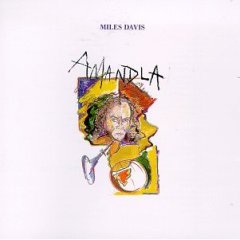Top Qs
Timeline
Chat
Perspective
Amandla (album)
1989 studio album by Miles Davis From Wikipedia, the free encyclopedia
Remove ads
Amandla is an album by jazz musician Miles Davis, released in 1989. The word Amandla holds significance in various Nguni languages, including Zulu and Xhosa, where it translates to "power." It is the third collaboration between Miles Davis and producer/bassist Marcus Miller, following their previous works Tutu (1986) and Music from Siesta (1987), and it serves as their final album together.
Remove ads
The album mixes elements of the genres go-go, zouk, funk and jazz, combining electronic instruments with live musicians. The composition "Mr. Pastorius", featuring drummer Al Foster, is a tribute to late jazz bassist Jaco Pastorius.[10] "Catémbe" is a Mozambican and Angolan cocktail of red wine and cola.
Remove ads
Critical reception
In a contemporary review, DownBeat said Amandla possessed "a precise and consistent sound that flows through the shifting instrumental combinations and lingers after the music has stopped".[2] In The Rolling Stone Album Guide (2004), J. D. Considine felt the record sounded "vaguely African" and somewhat conservative because of its reliance on session musicians.[7]
Track listing
All tracks are written by Marcus Miller, except where noted.
Personnel
Summarize
Perspective
- Miles Davis – trumpet
- Marcus Miller – arrangements (1, 3–8), keyboards (1, 3–6, 8), guitars (1, 4, 7), bass, drums (1), bass clarinet (1–4, 7, 8), soprano saxophone (1, 3), additional keyboards (2, 7)
- George Duke – keyboards (2), Synclavier (2), arrangements (2)
- Joey DeFrancesco – additional keyboards (2)
- Joe Sample – acoustic piano (6)
- John Bigham – keyboards (7), guitars (7), drum programming (7), arrangements (7)
- Jason Miles – synthesizer programming (8)
- Michael Landau – guitars (2)
- Foley – guitars (3, 4, 7)
- Jean-Paul Bourelly – guitars (3, 5)
- Billy "Spaceman" Patterson – wah-wah guitar (7)
- Ricky Wellman – drums (3, 7)
- Omar Hakim – drums (4, 6)
- Al Foster – drums (8)
- Don Alias – percussion (1, 3, 6)
- Mino Cinelu – percussion (1)
- Paulinho da Costa – percussion (4, 5)
- Bashiri Johnson – percussion (6)
- Kenny Garrett – alto saxophone (1, 3–7), soprano saxophone (2)
- Rick Margitza – tenor saxophone (5)
Production
- Miles Davis – executive producer, cover artwork
- Tommy LiPuma – producer (1, 3–8)
- Marcus Miller – producer (1, 3–8)
- George Duke – producer (2)
- John Bigham – associate producer (7)
- Eric Calvi – recording (1, 3–8)
- Bruce Miller – recording (1, 3–8)
- Erik Zobler – recording (2)
- Al Schmitt – additional recording
- Henry Falco – additional engineer
- Alec Head – additional engineer
- Debi Cornish – assistant engineer
- Kevin Fisher – assistant engineer
- Mitch Gibson – assistant engineer
- Roy Hendrickson – assistant engineer
- Ed Korengo – assistant engineer
- Scott Mabuchi – assistant engineer
- Joe Martin – assistant engineer
- Danny Mormando – assistant engineer
- Dave Wolk – assistant engineer
- Bill Schnee – mixing
- Doug Sax – mastering
- Bibi Green – production coordinator
- Rosemary Kraitz – production coordinator
- Stephanie McCravey – production coordinator
- Jo Gelbard – cover artwork
- Richard Rothman – photography
Studios
- Recorded at Clinton Recording Studios, Electric Lady Studios, The Power Station, Right Track Recording and Quadrasonic Studio (New York City, New York); Le Gonks West (West Hollywood, California); Ocean Way Recording (Hollywood, California).
- Mixed at Bill Schnee Studios (North Hollywood, California).
- Mastered at The Mastering Lab (Hollywood, California).
Remove ads
References
External links
Wikiwand - on
Seamless Wikipedia browsing. On steroids.
Remove ads

